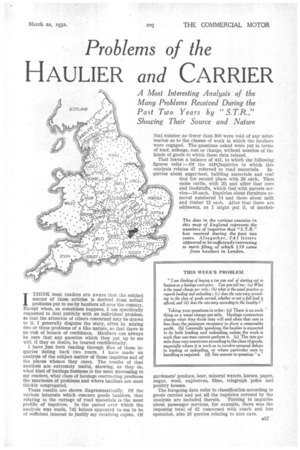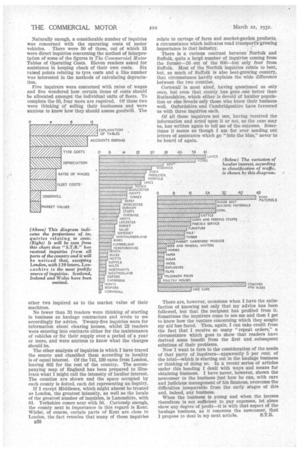Problems of the
Page 55

Page 56

If you've noticed an error in this article please click here to report it so we can fix it.
HAULIER and CARRIER ITHINK most readers are aware that the subject matter of these articles is derived from actual problems put to me by hauliers all over the country. Except when, as sometimes happens, I am specifically requested to deal publicly with an individual problem, so that the attention of others concerned may be drawn to it, I generally disguise the story, often by mixing two or three problems of a like nature, so that there is no risk of breach of confidence. Hauliers can always be sure that any question which they put up to me will, if they so desire, be treated confidentially. I have just been reading through files of these inquiries dating back two years. I have made an analysis of the subject matter of those inquiries and of the places whence they came. The results of that analysis are extremely useful, showing, as they do, what kind of haulage business is the most interesting to my readers, what class of haulage contracting produces the maximum of problems and where hauliers are most thickly congregated.
These results are shown diagrammatically. Of the various interests which concern goods hauliers, that relating to the cartage of road materials is the most prolific of inquiries. In the period over which the analysis was made, 741 letters appeared to me to be of sufficient interest to justify my retaining copies. Of
that number no fewer than 300 were void of any information as to the classes of work in which the hauliers were engaged. The questions asked were put in terms of load, mileage, cost or charge, without mention of the kinds of goods to which these data related.
That leaves a balance of 441, to which the following figures refer :—Of the 44K1nquiries to which this
analysis relates 47 referred to road materials. Inquiries about sugar-beet, building materials and coal tied for second place with 28 each. Then came cattle, with 20, and after that corn
and foodstuffs, which tied with parcels service-16 each. Inquiries about furniture removal numbered 14 and those about milk and timber 13 each. After that there are oddments, as I might put it, of market gardeners' produce, beer, mineral waters, horses, paper, sugar, wool, explosives, films, telegraph poles and poultry houses. The foregoing data refer to classification according to goods carried and not all the inquiries covered by the analysis are included therein. Turning to inquiries about passenger services, for example, there was the imposing total of 42 concerned with coach and bus operation, also 16 queries relating to hire ears.
Naturally enough, a considerable number of inquiries was concerned with the operating costs of motor vehicles. There were 50 of these, out of which 13 were direct inquiries concerning the method of interpretation of some of the figures in The Commercial Motor Tables of Operating Costs. Eleven readers asked for assistance in keeping check of their own costs. Six raised points relating to tyre costs and a like number was interested in the methods of calculating depreciation.
Five inquirers were concerned with rates of wages and five wondered how certain items of costs should be allocated amongst the individual units of fleets. To complete the 50, four more are required. Of these two were thinking of selling their businesses and were anxious to know how they should assess goodwill. The other two inquired as to the market value of their machines.
No fewer than 33 readers were thinking of starting In business as haulage contractors and wrote to me accordingly for advice. Twenty-five inquiries were for information about clearing houses, whilst 23 readers were entering into contracts either for the maintenance of vehicles or for their supply over a period of a year or more, and were anxious to know what the charges should be.
The other analysis of inquiries in which I have traced the source and classified them according to locality is of equal interest. Of the 741, 139 came from London, leaving 602 for the rest of the country. The accompanying map of England has been prepared to illustrate what I might call the intensity of haulier interest. The counties are shown and the space occupied by each county is dotted, each dot representing an inquiry.
If I except Middlesex, which might almost be treated as London, the greatest intensity, as well as the locale of the greatest number of inquiries, is Lancashire, with 61. Yorkshire comes next with 56. Curiously enough, the county next in importance in this regard is Kent. Whilst, of course, certain parts of Kent are close to London, the fact remains that many of these inquiries
B38 relate to cartage of farm and market-garden products, a circumstance which indicates road transport's 'growing importance to that industry.
There is a curious contrast between Norfolk and Suffolk, quite a large number of inquiries coming from the former-26 out of the 600—but only four from Suffolk. Most of the Norfolk inquiries relate to beet, but, as much of Suffolk is also beet-growing country, that circumstance hardly explains the wide difference between the two counties.
Cornwall is most aloof, having questioned us only once, but even that county has gone -one better than Rutlandshire, which either is devoid of haulier population or else breeds only those who know their business well. Oxfordshire and Cambridgeshire have favoured us with three inquiries each.
Of all those inquirers not one, having received the information and acted upon it or not, as the case may be, has written again to tell me of the outcome. Sometimes it seems as though I am for ever sending out letters of assistance which go "Into the blue," never to be heard of again.
There are, however, occasions when I have the satisfaction of knowing not only that my advice has been followed, but that the recipient has profited from it. Sometimes the inquirers come to see me and then I get to know how the venture concerning which they sought my aid has fared. Then, again, I can take credit from the fact that I receive so many "repeat orders," a circumstance which goes to show that readers have derived some benefit from the first and subsequent solutions of their problems.
Now I want to turn to the consideration of the needs of that party of inquirers—apparently 5 per cent. of the total—which is starting out in the haulage business or thinking of doing so. In a recent series of articles under this heading I dealt with ways and means for obtaining business. I have never, however, shown the newcomer to the business just how he can, with care and judicious management of his finances, overcome the difficulties inseparable from the early stages of this and, indeed, any business. When the business is young and when the income therefrom is not sufficient to pay expenses, let alone show any degree of profit—it is with that aspect of the haulage business, as it concerns the newcomer, that I propose to deal in my next article. S.T.R.




































































































